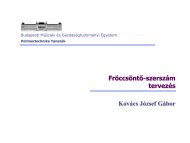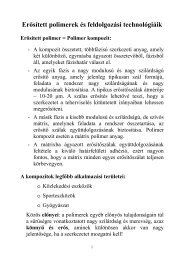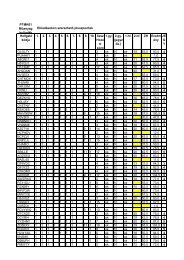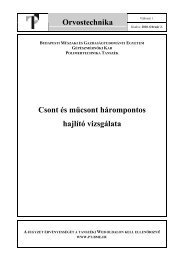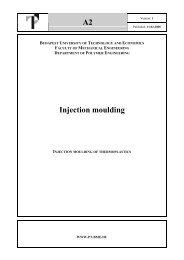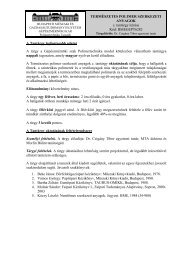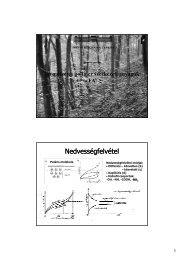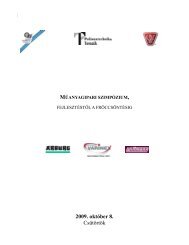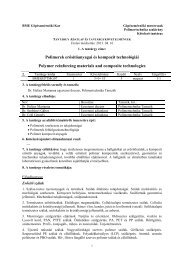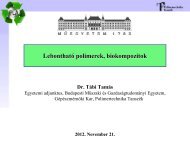Swelling, compression and tribological behaviors of ...
Swelling, compression and tribological behaviors of ...
Swelling, compression and tribological behaviors of ...
Create successful ePaper yourself
Turn your PDF publications into a flip-book with our unique Google optimized e-Paper software.
BENTONITE-MODIFIED POLYACRYLATE-TYPE HYDROGELS 1127line with the rather high amount <strong>of</strong> the soluble fraction(SF ¼ 10–12 %). In addition, it should be bornein mind that the efficiency <strong>of</strong> MbAAm is between 50<strong>and</strong> 64%. 21<strong>Swelling</strong> kinetics<strong>Swelling</strong> kinetics is a very important characteristic <strong>of</strong>hydrogels, as it provides information on the diffusioncharacter <strong>and</strong> velocity <strong>of</strong> water sorption, as well asthe time needed until equilibrium state is reached.Typical swelling curves (Q vs. time) <strong>of</strong> the clay-freehydrogel <strong>and</strong> its bentonite reinforced version are presentedin Figure 3(a). It can be seen that the unmodifiedhydrogel reaches equilibrium during the first 80h <strong>and</strong> demonstrates a high swelling degree (up to 200g <strong>of</strong> water per 1 g <strong>of</strong> dry polymer, Table II). However,after modification the swelling ratio <strong>of</strong> NB-modifiedhydrogel is almost two times lower <strong>and</strong> at the sametime its swelling rate is significantly higher. The lowerwater uptake <strong>of</strong> H-NB gel is evidently due to theenhanced crosslink density. Similar behavior was alsoobserved by Kabiri’s research group, when introducingchitosan-modified montmorillonite (MMT) intothe poly(AMPSA)-based gels up to 6%, 22 or kaolininto poly(acrylic acid)-based hydrogels. 23To investigate the mechanism <strong>of</strong> diffusion <strong>of</strong> watermolecules within the gels, the initial swelling datawere fit to the equation:QðtÞ ¼kt n (9)Figure 3 Water uptake curves (a) <strong>and</strong> their double logarithmicrepresentations (b). Notes: slopes are fitted to thelinear region <strong>of</strong> the swelling curve. The kinetic exponent,n, is depicted in the legend.where Q(t) is the measured swelling ratio at time t, kis the swelling rate front factor, <strong>and</strong> n is the kineticexponent. This equation is a phenomenological law,in which n is related to the type <strong>of</strong> sorption mechanisms<strong>of</strong> hydrogels. When n is equal to 0.5, it indicatesFickian diffusion (Case I), which ischaracterized by a solvent diffusion rate muchslower than that <strong>of</strong> the polymer relaxation. The otherextreme, when n ¼ 1, indicates non-Fickian (Case II)diffusion, where the diffusion process is faster thanthe relaxation rate. Another case <strong>of</strong> non-Fickian diffusion(anomalous) describes the cases where thediffusion <strong>and</strong> relaxation rates are comparable, so n¼ 0.5–1. 24 The value <strong>of</strong> n can be obtained as a slopefrom the double logarithmic plot <strong>of</strong> swelling ratio(Q) vs. time <strong>of</strong> swelling (t), in the linear part <strong>of</strong>swelling curve, <strong>and</strong> in our case this time intervalis 10 h.As it is shown in Figure 3(b), the value <strong>of</strong> n wasdetermined as 0.74 for the initial H-gel <strong>and</strong> 0.64 forthe modified H-NB gel suggesting the non-Fickiananomalous mechanism <strong>of</strong> water sorption for bothgels. Such swelling behavior is typical for ionicgels 25 <strong>and</strong> is caused by their large affinity towardwater due to the repulsive forces between the ionizablegroups. However, it is seen that NB-modifiedhydrogel swells faster than the reference [Fig. 3(a)],<strong>and</strong> its diffusion is closer to Case I than that <strong>of</strong> thepristine gel [Fig. 3(b)]. This fact may be explained bythe presence <strong>of</strong> strongly hydrophilic clay whichattracts water at the beginning <strong>of</strong> swelling muchfaster. This is accompanied by a faster relaxation <strong>of</strong>polymer chains between crosslinks due to theirshorter length (crosslinking degree <strong>of</strong> H-NB ishigher; therefore, the mean molecular weight <strong>of</strong>macromolecules between the crosslinks is lower).Water state characterizationThe Differential scanning calorimetry (DSC) methodis extensively used to get information on the interaction<strong>of</strong> water <strong>and</strong> polymers in the hydrated state <strong>of</strong>the latter. 26–28 Investigators differentiate between atJournal <strong>of</strong> Applied Polymer Science DOI 10.1002/app
1128 KORRES ET AL.Figure 4DSC curves <strong>of</strong> swollen hydrogels.least three types <strong>of</strong> water in swollen polymers: freewater (water with the same freezing point as bulkwater, i.e., near to 0 C), freezing bound water (waterfreezing at a temperature much lower than 0 C),<strong>and</strong> nonfreezing bound water (water that does notform ice at all <strong>and</strong> therefore cannot be detecteddirectly by calorimetry). 26 DSC analysis allows toestimate the amount <strong>of</strong> freezable (free <strong>and</strong> freezingbound) water from enthalpies <strong>of</strong> its phase transitions(melting/crystallization) quantitatively. In this work,the DSC analysis <strong>of</strong> water-swollen gels was carriedout during the heating process.As no endothermic peaks were observed in theregion below 0 C (Fig. 4), <strong>and</strong> considering the factthat the detection <strong>of</strong> different types <strong>of</strong> freezablewater (<strong>and</strong> their melting enthalpy) is significantlyaffected by the annealing period before DSC scanning,27 it was suggested that there is no freezablebound water in our gels. So, the phase transitionwas assigned to the melting <strong>of</strong> free water. Itsamount in the gels was evaluated from the meltingenthalpies using the following equation:W f ¼ DH endoDH ice 100 (10)where DH ice is the enthalpy <strong>of</strong> fusion <strong>of</strong> pure water(334 J/g), DH endo is the enthalpy values associatedwith melting peaks <strong>of</strong> freezable water in gels determinedas an area under the melting peak from DSCdata. 28 The amount <strong>of</strong> bound water was evaluatedfrom the assumption that equilibrium total watercontent represents the sum <strong>of</strong> the amount <strong>of</strong> freezable<strong>and</strong> nonfreezable water:W b ¼ EWC W f (11)where W b is the amount <strong>of</strong> nonfreezing boundwater. The results <strong>of</strong> EWC, enthalpy value, <strong>and</strong> calculatedamount <strong>of</strong> free <strong>and</strong> bound water related tothe weight <strong>of</strong> the dry polymer in the hydrogels arepresented in Table II.From the data obtained, it can be seen that both H<strong>and</strong> H-NB hydrogels contain very high amounts <strong>of</strong>water (more then 99%), which correlates with theirhigh hydrophilicity. However, in spite <strong>of</strong> the insignificantlylower water content <strong>of</strong> H-NB gel (99.09 %compared to 99.49% <strong>of</strong> H-gel, see Table II), its enthalpy<strong>of</strong> melting is notably lower than that <strong>of</strong> thereference gel (227 J/g compared to 283.6 J/g for thepristine gel). This indicates a considerably lowercontent <strong>of</strong> freezable water in the H-NB system (TableII). Because <strong>of</strong> the presence <strong>of</strong> ionic functionalgroups <strong>of</strong> AMPSA, the amount <strong>of</strong> bound water wasrather high <strong>and</strong> was found to be 14.66% for the clayfreegel. Modification by 4 wt % NB significantlyincreased the content <strong>of</strong> bound non-freezable water,i.e., up to 31.41%. It should also be noted that thetemperature <strong>of</strong> ice melting determined from DSCcurve <strong>of</strong> the NB-modified gel is notably lower thanthat for the H-gel (4.5 compared to 1 C, see Fig. 4).Such a depression in the melting point demonstratesa more bonded state <strong>of</strong> freezable water in a claymodifiedhydrogel matrix compared to the parentgel. Accordingly, the water state was influencedmarkedly by the inorganic clay. These results indicatea strong interaction <strong>of</strong> water molecules with theclay layers, <strong>and</strong> these interactions were notdestroyed during the hydrogel formation. This factmay significantly influence the mechanical <strong>and</strong> <strong>tribological</strong>properties <strong>of</strong> clay-modified hydrogels.Mechanical properties <strong>of</strong> the hydrogelsThe stress–strain curves <strong>of</strong> uniaxial <strong>compression</strong>tests <strong>of</strong> equilibrium swollen at 25 C hydrogels arepresented in Figure 5(a), whereas Figure 5(b) showsthe initial part <strong>of</strong> experimental curves at small deformations.As seen in Figure 5(a), the incorporation <strong>of</strong>4 wt % NB increased the ultimate <strong>compression</strong>strength (r) at break from 20 to 35 kPa; however, atthe same time, it slightly reduced the correspondingstrain (from 60 to 50%) compared to the unmodifiedgel. This indicates a significant improvement in thecompressive mechanical properties due to the claymodification. The slight reduction <strong>of</strong> strain is obviouslydue to the higher network density <strong>of</strong> NBmodifiedgel, <strong>and</strong> to the lower amount <strong>of</strong> water, thatmakes the gel stronger. An additional straightforwardexplanation is that the exfoliated/intercalatedbentonite layers may change their orientation underloading, while enhancing the maximum (or criticalwhere the hydrogel breaks apart) stress.In the swollen state, most hydrogels demonstratea rubber-like elastic behavior with a rapid rearrangement<strong>of</strong> the polymer segments under externalJournal <strong>of</strong> Applied Polymer Science DOI 10.1002/app
BENTONITE-MODIFIED POLYACRYLATE-TYPE HYDROGELS 1129modulus correlates with crosslink-density <strong>of</strong> swollennetwork (n c ) as follows:E ¼ RTv p n c (14)Figure 5 Typical DMA <strong>compression</strong> stress–strain curves(a) <strong>and</strong> the straight lines fits to the experimental data inthe initial deformation range (represents the elastic modulusE) (b). Note: data presented are linked with the averagefrom 10 experiments for each gel.stresses. In such a state, the mechanical behavior <strong>of</strong>gels is dependent mainly on the architecture <strong>of</strong> thepolymer network. Then, the elastic modulus, E, canbe determined from the slope <strong>of</strong> the linear dependencein the following equation:r ¼ Eðk k 2 Þ (12)where r is the applied compressive stress, k is therelative deformation:k ¼ L=L 0 (13)where L is the deformed thickness <strong>and</strong> L 0 is the initialthickness <strong>of</strong> a sample before deformation. 29 Thefitted lines used for the determination <strong>of</strong> E as theirslope value are shown in Figure 5(b). The elasticwhere R is the universal gas constant, T is the temperature,v p is the volume fraction <strong>of</strong> polymer inswollen gel, <strong>and</strong> n c is the concentration <strong>of</strong> crosslinkjoints per unit volume. It should be noted that thisapproach <strong>of</strong> crosslink density determination doesnot consider the molecular structure <strong>of</strong> the gel <strong>and</strong>its interaction with the solvent <strong>and</strong> is concernedonly with the observed macroscopic behavior <strong>of</strong> thesystem.Comparing the results obtained for the hydrogels’crosslink density by two approaches (using equilibriumswelling (n c Q ) <strong>and</strong> elastic modulus (n c E ) forcalculations, Table II), it can be seen that the crosslinkdensity determined via elastic modulus is about10 times higher than that determined by swelling.This can be explained by the fact that these twomethods reflect different properties <strong>of</strong> the hydrogels.As mentioned above, the mechanical approach doesnot take into account the chemical nature <strong>of</strong> hydrogelnetwork, its affinity to solvent (water here), orelectrostatic forces in ionic hydrogels. However, forthe clay-modified gels during swelling, the interaction<strong>of</strong> bentonite with water was not taken intoaccount. This interaction may change the Flory-Hugginsparameter v 12 <strong>and</strong> influence the calculated n c .On the other h<strong>and</strong>, the modulus <strong>of</strong> elasticity ismainly influenced by the number <strong>of</strong> elastically effectivechains <strong>of</strong> the hydrogel network <strong>and</strong>, very significantly,by the entanglements <strong>and</strong> micro-heterogeneities<strong>of</strong> the network, which are typical for this kind<strong>of</strong> hydrogels. 30 So, from a practical viewpoint, thedetermination <strong>of</strong> the network density from mechanicaltests is favorable. It should be noted that the values<strong>of</strong> n c , determined from the mechanical tests, arealso much lower compared to the theoretical crosslinkdensity. Similar effects were observed by otherscientists, as well. 21Sliding friction <strong>and</strong> wearFigure 6 shows the time pr<strong>of</strong>iles <strong>of</strong> the COF <strong>of</strong> thehydrogels investigated. As it can be seen for H-gel,its COF is very low in spite <strong>of</strong> the relatively highroughness <strong>of</strong> the metallic shaft counterpart (TableII). Very low values <strong>of</strong> COF for AAm-AMPSA-basedhydrogels have already been reported by Gonget al. 12,13 <strong>and</strong> were attributed to the strong repulsiveforces <strong>of</strong> negatively charged ionic groups <strong>of</strong> AMPSA.They also reported that friction coefficient tends todecrease when raising the charge density <strong>of</strong> a surface<strong>of</strong> ionic hydrogels. 13Journal <strong>of</strong> Applied Polymer Science DOI 10.1002/app
1130 KORRES ET AL.Figure 6 Tribological behavior <strong>of</strong> the reference (H, opensymbol) <strong>and</strong> bentonite-modified hydrgels (H-NB, filledsymbol). Solid curves represent the fits with experimentaldata.The friction <strong>of</strong> the 4 wt % NB gel was unexpectedlylow, in spite <strong>of</strong> the significantly lower swellingratio (Table II). A decrease <strong>of</strong> COF for clay-modifiedhydrogels was also observed by Haraguchi <strong>and</strong>Takada. 31 This was assigned to dangling <strong>of</strong> uncrosslinkedpolymer chain ends from exfoliated clay platelets,which affected the interface <strong>and</strong> reduced thefriction under wet conditions. On the other h<strong>and</strong>,this behavior may be related to changes in the surfaceproperties <strong>of</strong> the hydrogels. The presence <strong>of</strong>clay nanoparticles at the gels’ surface can rearrange<strong>and</strong> alter the surface polarity <strong>and</strong> morphology. Thisis accompanied by a change in the surface tension,which can reduce the friction. However, this hypothesisrequires further experiments.The specific wear rate (W S ) is remarkably lowerfor the NB-modified hydrogel when compared withthat <strong>of</strong> the reference (Table II). This suggests a reinforcingeffect <strong>of</strong> NB due to the strong adsorption <strong>of</strong>polymer chains on the filler surface, <strong>and</strong> strong H-bond interactions between the hydroxyl groups <strong>of</strong>the bentonite (at its surface) <strong>and</strong> functional groups<strong>of</strong> the copolymer network (carbonyl <strong>and</strong> aminogroups <strong>of</strong> AAm <strong>and</strong> AMPSA, respectively). All thisincreases the apparent crosslink degree. Thus,improvement in the <strong>compression</strong> mechanical properties<strong>of</strong> NB-modified hydrogel due to the nan<strong>of</strong>illerreinforcement is associated, at the same time, with ahigher resistance to sliding wear.Creep behaviorIn general, hydrogels are not simply elastic materialsbut behave viscoelastically <strong>and</strong> mechanical deformationleads to a time dependence on the appliedstress due to the movement <strong>of</strong> polymer chains segments.This movement induces an internal response,resulting in a time-dependent recovery when theexternal load is removed. Thus, the time dependence<strong>of</strong> the applied stress or strain is as important as theprediction <strong>of</strong> the material’s mechanical response.The investigation <strong>of</strong> the creep behavior makes thedetermination <strong>of</strong> the viscoelastic <strong>and</strong> viscoplasticresponses possible. In this work, the initial <strong>and</strong> NBreinforcedhydrogels were subjected to creep tests.The total deformation <strong>of</strong> hydrogels (e) after the loadcyclewas calculated as a ratio <strong>of</strong> thickness at theend <strong>of</strong> loading to the initial thickness <strong>of</strong> the samples.Additionally, the plastic (irreversible) deformation(d) was estimated as the strain value at the end <strong>of</strong>the recovery-cycle. The DMA method was applied ata relatively short load-cycle setting <strong>and</strong> TMA testswere carried out under several load-conditions withincreased durations for both load <strong>and</strong> relaxationcycles.Representative DMA creep <strong>and</strong> relaxation curvesare presented in Figure 7. At the beginning, the samplesresponded elastically to the initial mechanicalload yielding at 30 <strong>and</strong> 23% strain values for the H<strong>and</strong> H-NB gels, respectively. After 20 min <strong>of</strong> loading,the related strain (e) values reached 33 <strong>and</strong> 27%for H <strong>and</strong> H-NB, respectively (Table III). When theload was removed, the strain dropped suddenly to2.5–3% <strong>and</strong> within 3–4 min the initial thickness <strong>of</strong>the specimens was practically restored <strong>and</strong> d wasfound to be 0% for both H <strong>and</strong> H-NB gels. Such fastresponse <strong>of</strong> hydrogels to load changing conditionswas also observed by other investigators. 32Results <strong>of</strong> creep tests carried out by TMA at differentload conditions are presented in Figure 8. Thevalue <strong>of</strong> elastic (reversible) deformation (e) was evaluatedas the difference between e <strong>and</strong> d at the firstFigure 7 Compression creep <strong>and</strong> relaxation for thehydrogel samples in DMA. Notes: the applied load was 7kPa before deloading. The duration <strong>of</strong> both loading <strong>and</strong>deloading was 20 min.Journal <strong>of</strong> Applied Polymer Science DOI 10.1002/app
BENTONITE-MODIFIED POLYACRYLATE-TYPE HYDROGELS 1131SamplecodeLoad(kPa)TABLE IIICreep Characteristics <strong>of</strong> the HydrogelsDMA (load/relaxation:20/20 min)TMA (load/relaxation/load:120/240/120 min)e (%) d (%) e (%) 1 st cycle d (%) e (%) e (%) 2 nd cycleH 7 32.6 6 0.9 0 43.0 6 1.1 2.0 6 0.2 41.0 6 1.3 43.5 6 1.014 – – 51.5 6 1.3 2.5 6 0.2 49.0 6 0.9 53.9 6 1.218 – – 72.0 6 1.0 65.0 6 0.7 7.0 6 0.4aH-NB 7 27.3 6 1.0 0 38.5 6 0.6 1.5 6 0.1 37.0 6 0.6 39.9 6 0.414 – – 41.0 6 1.3 3.0 6 0.12 38.0 6 1.2 42.1 6 1.518 – – 57.8 6 1.2 5.0 6 0.5 52.8 6 1.7 58.0 6 1.2a Sample already destroyed.load-cycle. Results obtained at low load (7 kPa) arein good agreement with DMA creep data. However,longer load times (120 min instead <strong>of</strong> 20 min)resulted in higher deformation (Table III). Similarlyto the DMA creep behavior, after deloading, bothhydrogels recovered relatively fast: in 5 min the residualdeformation was 4–5% <strong>and</strong> then, in 240 min<strong>of</strong> relaxation, it was further reduced to 1.5–2%. As itcan be seen, the plastic deformation after the first120 min load-cycle is higher than that determined byDMA in a shorter loading time for both hydrogelsystems. These results indicate that longer loadingtime leads to more irreversible deformation in thehydrogels. As expected, when increasing the <strong>compression</strong>loads, the creep deformation rises for bothgels, <strong>and</strong> the creep is maximal under 18 kPa. At thesame time, for the H-NB gel, the deformation islower compared to the unmodified H-gel under allloading conditions. This is in good agreement withDMA creep investigations (Table III). It is also seenthat plastic deformation increases with the loadingforce. At 18 kPa load, the plastic deformation is veryhigh (65%) for the reference H-gel, indicating itsweak <strong>compression</strong> resistance (the gel network is alreadysignificantly destroyed). However, the modification<strong>of</strong> the hydrogel with 4 wt % NB significantlyimproved the creep behavior. For example, the irreversibledeformation was found to be 5% in the 18kPa creep load regime. After the second load-cycle,the final deformation <strong>of</strong> the hydrogels is higher thanafter the first loading. This confirms some destruction<strong>of</strong> the gel network due to the first loading cycle.However, for the clay-reinforced samples, the deformationafter the second load-cycle changed insignificantly.These results indicate significant improvement<strong>of</strong> their <strong>compression</strong> resistance against ‘‘longterm’’deformations due to the reinforcement <strong>of</strong>AAm-AMPSA hydrogels by inorganic clay. Recallthat this modification had no negative impact on theCOF (as discussed in section above) in spite <strong>of</strong> thelower water content.SEM investigationsThe surface morphology <strong>of</strong> the hydrogels after dryingis presented in Figure 9. The slight surface waviness<strong>of</strong> the reference system detected at higher magnificationsmay be explained by a nonuniformcontraction <strong>of</strong> the hydrogel during drying. Significantchanges in the surface morphology <strong>of</strong> the sampleswere observed after the NB modification <strong>of</strong> thehydrogel. The dispersion <strong>of</strong> uniformly sized clayparticles is well resolved (SEM pictures in the bottomline <strong>of</strong> Fig. 9). Although the NB filler was welldispersed in the matrix, the presence <strong>of</strong> largeragglomerates with sizes up to 10 lm could also bedetected. This agglomeration probably representsthe nonexfoliated (i.e., intercalated) portion <strong>of</strong> theFigure 8 Compression creep <strong>and</strong> relaxation behavior <strong>of</strong>H-reference (a) <strong>and</strong> H-NB (b) hydrogels under differentloading conditions in a TMA device. Note: the appliedload is depicted in the legend.Journal <strong>of</strong> Applied Polymer Science DOI 10.1002/app
1132 KORRES ET AL.Figure 9 SEM images <strong>of</strong> the dried surfaces <strong>of</strong> H-reference (top) <strong>and</strong> H-NB (bottom) hydrogels at differentmagnifications.NB. Note that the formation <strong>of</strong> agglomerates mayalso be triggered during the drying <strong>of</strong> the hydrogel.Figure 10(a) demonstrates that the reference H-gelis transparent in equilibrium swollen state. However,the NB modification makes the hydrogelslightly hazy [Fig. 10(b)] compared to the reference.This suggests the presence <strong>of</strong> microscaled agglomeratesin the H-NB system. On the other h<strong>and</strong>, SEMpictures demonstrate the good bonding between thefiller <strong>and</strong> polymer matrix (cf. Fig. 9). The latter isdue to the strong interaction <strong>of</strong> the polymer functionalgroups with the absorption centers (OHgroups)<strong>of</strong> the clay platelets via H-bonding. Chemicalreactions between the ASO 3 H group <strong>of</strong> AMPSA<strong>and</strong> the metallic structural components <strong>of</strong> the claycannot be excluded, either. Moreover, ionic interactionsbetween the SO – 3 anions <strong>of</strong> AMPSA <strong>and</strong> claycations (i.e., Na þ ) may also be present. These interactionscause the reorganization <strong>of</strong> polymer chainsnear the filler particles <strong>and</strong> change the surface morphology<strong>of</strong> the clay-reinforced hydrogel. This factmay be a reason for the significant improvement <strong>of</strong>the mechanical properties <strong>and</strong> resistance to slidingwear compared to that <strong>of</strong> the pristine gel.To investigate the structural changes <strong>of</strong> the hydrogels’surface due to the filler in more detail, theFigure 10Photos <strong>of</strong> the swollen H (a) <strong>and</strong> H-NB (b) hydrogels.Journal <strong>of</strong> Applied Polymer Science DOI 10.1002/app
BENTONITE-MODIFIED POLYACRYLATE-TYPE HYDROGELS 1133nanosized clay platelets, uniformly distributed in theH-NB matrix, <strong>and</strong> their low intensity is probablydue to the low concentration <strong>of</strong> NB on the surface. Itis interesting to notice that the peak intensity ratios<strong>of</strong> carbon/sulfur, oxygen/sulfur <strong>and</strong> nitrogen/sulfurelements increased from about 1, 0.5, <strong>and</strong> 0.1 for H-reference to about 20, 2, <strong>and</strong> 0.2, respectively, for theH-NB hydrogel. This suggests that instead <strong>of</strong>AMPSA-units now AAm-units are mostly present atthe specimens’ surface. The AMPSA-units aremainly in close vicinity <strong>of</strong> the clay particles due tostrong ionic interactions. The latter can be confirmedby the detection <strong>of</strong> sulfur <strong>and</strong> carbon peaks on thesurface <strong>of</strong> clay agglomerates [Fig. 11(c)]. The higherintensity <strong>of</strong> the oxygen peak here is obviouslyderived from the NB structure <strong>and</strong> is due to theadditive effect <strong>of</strong> organic (in structure <strong>of</strong> the sulfonatedunits) <strong>and</strong> inorganic (in structure <strong>of</strong> the clay)oxygen atoms. It should be noted that the higher intensity<strong>of</strong> the recorded peaks for the NB-modifiedsample [Fig. 11(b,c)] should be attributed to thehigher conductivity <strong>of</strong> the sample’s surface. This factclearly indicates an increase in the surface chargedensity, which may play an important role in thereduction <strong>of</strong> the COF. Moreover, the localization <strong>of</strong>ASO 3 H containing units on the NB surface can beanother reason for the decrease <strong>of</strong> the COF, in additionto the reinforcing effect <strong>of</strong> NB (decreasing thewear rate) when comparing to the H-reference. Thisassumption is based on literature data reporting thatthe incorporation <strong>of</strong> sulfonated monomers in acrylicbased hydrogels decreased their COF. 12,13Figure 11 SEM-EDS spectra acquired from the surfaces<strong>of</strong> dried H (a) <strong>and</strong> H-NB (b <strong>and</strong> c) hydrogels. Notes: spectrab <strong>and</strong> c were taken from surfaces <strong>of</strong> H-NB with uniformclay dispersion <strong>and</strong> from a clay-rich agglomerate,respectively. Au <strong>and</strong> Pd peaks are owing to the conductivesurface coating.dried hydrogel samples were subjected to SEM-EDSanalysis, i.e., for element mapping <strong>of</strong> their surfaces.The results obtained are presented in Figure 11.Although all specimens were covered by conductiveAu/Pd alloy, the intensity <strong>of</strong> the characteristic peaks<strong>of</strong> the H-reference sample was very low [Fig. 11(a)]due to the low conductivity <strong>of</strong> organic matrix. However,it can be clearly seen that sulfur <strong>and</strong> carbonare the dominant elements in the spectrum, whichindicates that sulfonated units <strong>of</strong> AMPSA are mostlylocalized on the sample’s surface. For the bentonitemodifiedsample, the element analysis <strong>of</strong> the surfaceareas free <strong>of</strong> clay agglomerates [Fig. 11(b)] demonstratesa redistribution <strong>of</strong> elements compared to theH-sample. The presence <strong>of</strong> the peaks that are typicalfor NB (Na, Al, <strong>and</strong> Si) confirms the existence <strong>of</strong>CONCLUSIONSBased on this work devoted to study <strong>of</strong> the effects <strong>of</strong>sodium bentonite (NB added in 4 wt %) modificationon the swelling, mechanical <strong>and</strong> sliding wearproperties <strong>of</strong> a hydrogel synthesized from acrylamide(AAm) <strong>and</strong> 2-acryloylamido-2-methylpropanesulfonicacid (AMPSA) monomers (weight ratio: 1/1) <strong>and</strong> methylene-bisacrylamide crosslinking agent,the following conclusions can be drawn:a. Network structure <strong>and</strong> morphology: The crosslinkdensity, derived from swelling <strong>and</strong> <strong>compression</strong>tests, was below that <strong>of</strong> theoretical value. The incorporation<strong>of</strong> NB increased the apparent crosslink density<strong>of</strong> the related hydrogel. This was traced to theformation <strong>of</strong> additional crosslinks via covalent <strong>and</strong>ionic interactions between the clay <strong>and</strong> matrix formingmonomers. NB also affected the surface composition<strong>of</strong> the related hydrogel according to the SEM-EDS results.b. Water uptake <strong>and</strong> content: The NB incorporationcaused a slight reduction <strong>of</strong> the water contentbut a markedly high decrease in the water uptake.This was attributed to an enhancement in theJournal <strong>of</strong> Applied Polymer Science DOI 10.1002/app
1134 KORRES ET AL.apparent crosslink density. The swelling was fasterin the presence <strong>of</strong> NB, which was explained by a differencein the hydration <strong>behaviors</strong> <strong>of</strong> the clay modified<strong>and</strong> the pristine hydrogel copolymers. The swellingkinetics <strong>of</strong> the hydrogels with <strong>and</strong> without NBshowed characteristics between Fickian <strong>and</strong> non-Fickian <strong>behaviors</strong> affected by the NB presence.According to the DSC results, the incorporation <strong>of</strong>NB yielded a pronounced increase in the nonfreezingbound water content.c. Compression mechanical properties: The addition<strong>of</strong> NB strongly improved the <strong>compression</strong>strength which was accompanied by a slight reductionin the ultimate strain. This was attributed to ahigher apparent crosslink density <strong>of</strong> the modifiedhydrogel, <strong>and</strong> its nanoscaled reinforcement by clayplatelets. The latter effect turned out to be most evidentin the <strong>compression</strong> creep experiments. The elasticrecovery was faster, the irreversible deformationsubstantially lower, <strong>and</strong> the creep loadability prominentlyhigher for the clay-modified hydrogel whencompared with the parent one.d. Sliding friction <strong>and</strong> wear: The incorporation <strong>of</strong>NB reduced both the COF <strong>and</strong> the specific wear ratein water lubricated tests. This was traced by compositionalchanges in the surface layer <strong>of</strong> the hydrogel,<strong>and</strong> the reinforcing action (enhancement in the apparentcrosslink density <strong>and</strong> nanoplatelet-type reinforcement)<strong>of</strong> NB.References1. Kopecek, J.; Yang, J. Y. J Polym Int 2007, 56, 1078.2. H<strong>of</strong>fman, A. S. Adv Drug Delivery Rev 2002, 54, 3.3. Drury, J. L.; Mooney, D. J. Biomaterials 2003, 24, 4337.4. Peppas, N. A.; Hilt, J. Z.; Khademhosseini, A.; Langer, R. AdvMater 2006, 18, 1345.5. Gabler, S.; Stampfl, J.; Koch, T.; Seidler, S.; Schuller, G.; Redl,H.; Juras, V.; Tratting, S.; Weidisch, R. Int J Mater Eng Innov2009, 1, 3.6. Vicosa, A. L.; Gomes, A. C. O.; Soares, B. G.; Paranhos, C. M.Express Polym Lett 2009, 3, 518.7. Crockett, R. Tribol Lett 2009, 35, 77.8. Gong, J. P.; Kagata, G.; Iwasaki, Y.; Osada, Y. Chin J PolymSci 2000, 18, 271.9. Davim, J. P.; Marques, N. Tribol Lett 2001, 11, 91.10. Matzelle, T. R.; Herkt-Bruns, C.; Heinrich, L. A.; Kruse, N.Surf Sci 2000, 454, 1010.11. Ishikawa, Y.; Hiratsuka, K.; Sasada, T. Wear 2006, 261, 500.12. Gong, J.; Higa, M.; Iwasaki, Y.; Katsuyama, Y.; Osada, Y. JPhys Chem B 1997, 101, 5487.13. Gong, J.; Iwasaki, Y.; Osada, Y.; Kurihara, K.; Hamai, Y. JPhys Chem B 1999, 103, 6001.14. Kagata, G.; Gong, J. P.; Osada, Y. J Phys Chem B 2003, 107,10221.15. Kaneko, D.; Tada, T.; Kurokawa, T.; Gong, J. P.; Osada, Y.Adv Mater 2005, 17, 535.16. Flory, P. J. The Principles <strong>of</strong> Polymer Chemistry; Cornell UniversityPress: Ithaca, New York, 1953.17. Tominaga, T.; Tirumala, V. R.; Lee, S.; Lin, E. K.; Gong, J. P.;Wu., W. J Phys Chem B 2008, 112, 3903.18. Durmaz, S.; Okay, O. Polymer 2000, 41, 3693.19. Haraguchi, K.; Farnworth, R.; Ohbayashi, A.; Takehisa, T.Macromolecules 2003, 36, 5732.20. Ma, J.; Zhang, L.; Fan, B.; Xu, Y.; Liang, B. J Polym Sci B 2008,46, 1546.21. Aouada, F. A.; Guilherme, M. R.; Canpese, G. M.; Girotto, E.M.; Rubira, A. F.; Muniz, E. C. Polym test 2006, 25, 158.22. Kabiri, K.; Mirzadeh, H.; Zohuriaan-Mehr, M. J.; Daliri, M.Polym Int 2009, 25, 1252.23. Kabiri, K.; Zohuriaan-Mehr, M. J. Polym Adv Tech 2003, 14,438.24. Firestone, B. A.; Siegel, R. A. J Appl Polym Sci 1991, 43, 901.25. Lee, W.-F.; Chiu, R.-J. J Polym Res 2002, 9, 141.26. Yoshida, H.; Hatakeyama, T.; Hatakeyama, H. J Therm Anal1992, 40, 483.27. Roorda, W. J Biomater Sci Polym Edn 1994, 5, 383.28. Pissis, P.; Kyritsis, A.; Ferrer, G. G.; Pradas, M. M.; Ribelles, L.G. Subsurf Sensing Technol Appl 2000, 1, 417.29. Anseth, K. S.; Bowman, C. N.; Brannon-Peppas, L. Biomaterials1996, 17, 1647.30. Okay, O.; Durmaz, S. Polymer 2002, 43, 1215.31. Haraguchi, K.; Takada, T. Macromol Chem Phys 2005, 206,1530.32. Lopatin, V. V.; Askadskii, A. A.; Preegudov, A. S.; Vasil’ev, V.G. J Appl Polym Sci 2005, 96, 1043.Journal <strong>of</strong> Applied Polymer Science DOI 10.1002/app




